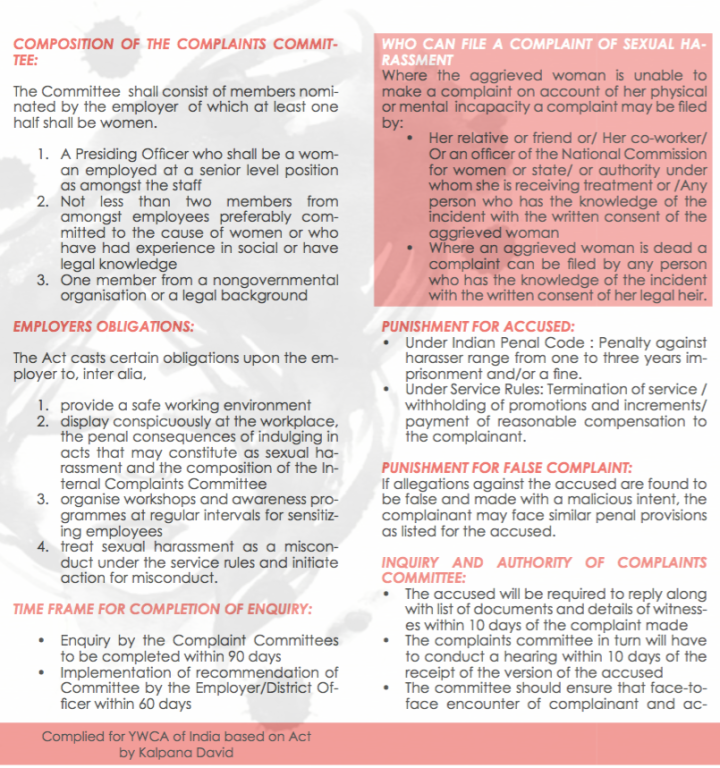Media cannot stress enough about the harassment of women as they go about their daily life. Be it at work, home or walking down the road, women are at risk. The key to protecting one self is not just self defence, it is also education. Education oneself about your rights is beneficial. Half information is no good. Be informed. Know your rights and at the same time do not abuse the knowledge that you have. As Peter Parker’s Uncle would say ‘With great power, comes great responsibility.’
This article highlights your rights as a women in the work force. It could happen to you or to someone you know. Share the informative, learn and spread awareness as well. But never, ever misuse the information at your fingertips. Because, in this day and age, media shares enough information for you to know, that even men and transgenders suffer harassment at a workplace as well as women.

DEFINITION OF SEXUAL HARASSMENT:
The Act defines sexual harassment as an – unwelcome sexual gesture or behaviour aimed or having a tendency to outrage the modesty of woman directly or indirectly. It includes:
• Sexually coloured remarks
• Physical contact and advances
• Showing pornography
• A demand or request for sexual favours
• Any other unwelcome physical, verbal/
non-verbal – such as whistling, obscene jokes, comments about physical appearances, threats, innuendos, gender based derogatory remarks, etc. Additionally it recognises the promise or threat to a woman’s employment prospects or creation of hostile work environment as ‘sexual harassment’ at workplace and expressly seeks to prohibit such acts.
TYPES of SEXUAL HARASSMENT:
- QUID PRO QUO HARASSMENT – Something for something – Harasser has position of power or authority and Refusal to submit will affect the victim‘s job.
- HOSTILE WORK ENVIRONMENT DUE TO HARASSMENT – Such conduct which unreasonably interferes with an individual’s work or performance or creates an unfriendly and uncomfortable work environment.
- SAME SEX HARASSMENT – Male harassment on another male, or female/or Harassment on another female.
- THIRD PARTY HARASSMENT – Sexual harassment by a non-employee, e.g. Vendors, Customers or Visitors/or Behaviour found offensive by other employees.
Companies can and should set up a complaints and redressal system. In fact it is the employer’s obligation to make sure his employees are protected and have the support that they require.
EMPLOYERS OBLIGATIONS:
The Act casts certain obligations upon the em- ployer to, inter alia,
- provide a safe working environment
- display conspicuously at the workplace, the penal consequences of indulging in acts that may constitute as sexual harassment and the composition of the Internal Complaints Committee
- organise workshops and awareness programmes at regular intervals for sensitizing employees
- treat sexual harassment as a misconduct under the service rules and initiate action for misconduct.
PUNISHMENT FOR FALSE COMPLAINT:
If allegations against the accused are found to be false and made with a malicious intent, the complainant may face similar penal provisions as listed for the accused.


SOME STEPS WOMEN CAN TAKE
1. Wake up, prevent spread of Sexual Harassment. Your rights are defended and you have equal opportunity in every area.
2. Empower yourself. Keep improving and expanding skills. Achieve jobs/promotions by merit and not because of ‘being a woman’.
3. Act, ask for specific rights, file written complaints and speak up.
4. Believe in yourself – your growth is within not outside you.
5. Be a part of the solution and not part of the problem.
6. Don’t face problems of sexual harassment in seclusion. Share with colleagues and seniors. Go to higher authorities if no solution is found.


